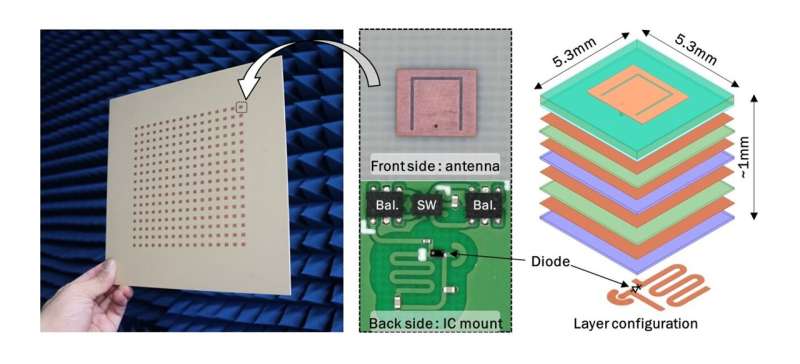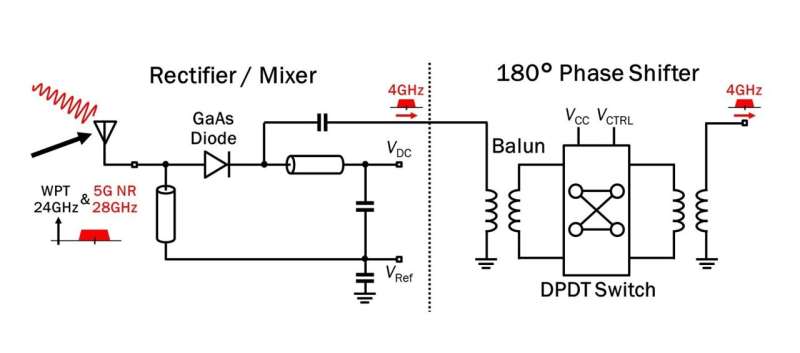This article has been reviewed according to Science X's editorial process and policies. Editors have highlighted the following attributes while ensuring the content's credibility:
fact-checked
peer-reviewed publication
trusted source
proofread
Towards wider 5G network coverage: Scientists design novel wirelessly powered relay transceiver array

A novel 256-element wirelessly powered transceiver array for non-line-of-sight 5G communication, featuring efficient wireless power transmission and high-power conversion efficiency, has been designed by scientists at Tokyo Tech.
The innovative design can enhance the 5G network coverage even to places with link blockage, improving flexibility and coverage area, and potentially making high-speed, low-latency communication more accessible.
Millimeter wave 5G communication, which uses extremely high-frequency radio signals (24 to 100 GHz), is a promising technology for next-generation wireless communication, exhibiting high speed, low latency, and large network capacity.
However, current 5G networks face two key challenges. The first one is the low signal-to-noise ratio (SNR). A high SNR is crucial for good communication. Another challenge is link blockage, which refers to the disruption in signal between transmitter and receiver due to obstacles such as buildings.
Beamforming is a key technique for long-distance communication using millimeter waves which improves SNR. This technique uses an array of sensors to focus radio signals into a narrow beam in a specific direction, akin to focusing a flashlight beam on a single point. However, it is limited to line-of-sight communication, where transmitters and receivers must be in a straight line, and the received signal can become degraded due to obstacles.
Furthermore, concrete and modern glass materials can cause high propagation losses. Hence, there is an urgent need for a non-line-of-sight (NLoS) relay system to extend the 5G network coverage, especially indoors.
To address these issues, a team of researchers led by Associate Professor Atsushi Shirane from the Laboratory for Future Interdisciplinary Research of Science and Technology at Tokyo Institute of Technology(Tokyo Tech) designed a novel wirelessly powered relay transceiver for 28 GHz millimeter-wave 5G communication. Their paper is published in the journal IEEE Microwave and Wireless Technology Letters.

Explaining the motivation behind their study, Shirane says, "Previously, for NLoS communication, two types of 5G relays have been explored: an active type and a wireless-powered type. While the active relay can maintain a good SNR even with few rectifier arrays, it has high power consumption.
"The wirelessly powered type does not require a dedicated power supply but needs many rectifier arrays to maintain SNR due to low conversion gain and uses CMOS diodes with lower than ten percent power conversion efficiency. Our design addresses their issues while using commercially available semiconductor integrated circuits (ICs)."
The proposed transceiver consists of 256 rectifier arrays with 24 GHz wireless power transfer (WPT). These arrays consist of discrete ICs, including gallium arsenide diodes, and baluns, which interface between balanced and unbalanced (bal–un) signal lines, DPDT switches, and digital ICs.
Notably, the transceiver is capable of simultaneous data and power transmission, converting 24 GHz WPT signal to direct current (DC) and facilitating 28 GHz bi-directional transmission and reception at the same time.
The 24 GHz signal is received at each rectifier individually, while the 28 GHz signal is transmitted and received using beamforming. Both signals can be received from the same or different directions and the 28 GHz signal can be transmitted either with retro-reflecting with the 24 GHz pilot signal or in any direction.
Testing revealed that the proposed transceiver can achieve a power conversion efficiency of 54% and a conversion gain of –19 decibels, higher than conventional transceivers while maintaining SNR over long distances. Additionally, it achieves about 56 milliwatts of power generation which can be increased even further by increasing the number of arrays. This can also improve the resolution of the transmission and reception beams.
"The proposed transceiver can contribute to the deployment of the millimeter-wave 5G network even to places where the link is blocked, improving installation flexibility and coverage area," said Shirane.
More information: Michihiro Ide et al, A 256-Element Phased-Array Relay Transceiver for 5G Network Using 24-GHz Wireless Power Transfer With Discrete ICs, IEEE Microwave and Wireless Technology Letters (2024). DOI: 10.1109/LMWT.2024.3395300



















